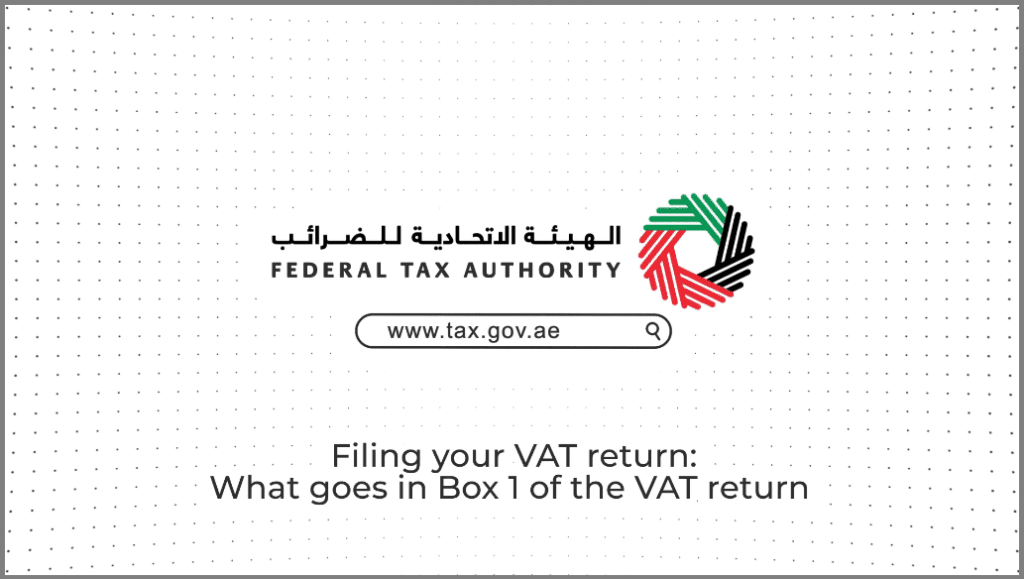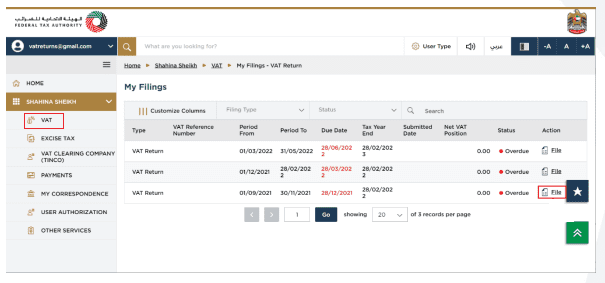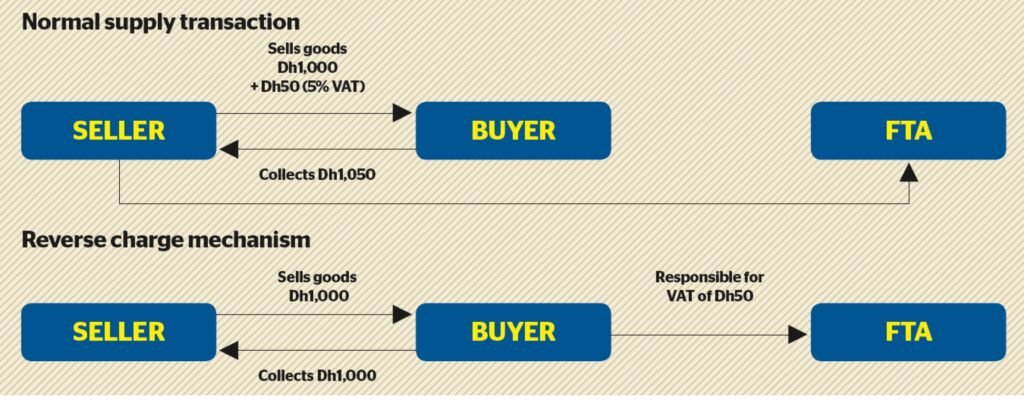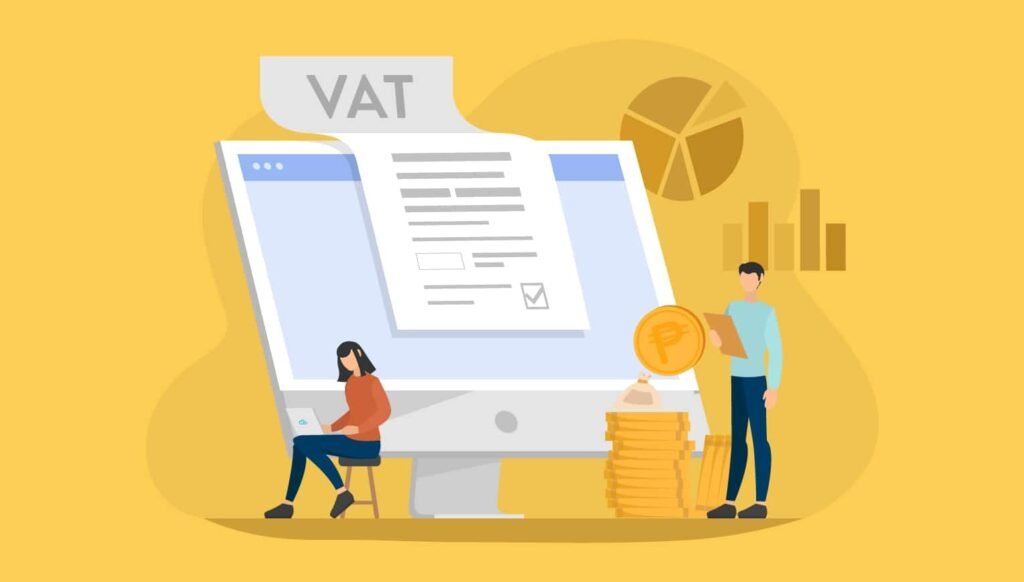Share
Table of Contents

All businesses registered under the value-added tax (VAT) in the United Arab Emirates (UAE), legally referred to as taxable persons, must report to the Federal Tax Authority (FTA) through VAT filing to ensure easy reporting and compliance. Typically, this process is carried out through the FTA’s Emaratax portal, where you manually enter details such as sales value, purchases, Output tax, and Input tax for the relevant tax period. If you are unsure how to proceed, here is a step-by-step guide to help you file your VAT return in the UAE.
What is VAT Filing?

VAT filing refers to when businesses registered under the value-added tax (VAT) system report their taxable transactions to the tax authorities. This involves documenting and submitting details of sales, purchases, Output tax payable (the tax you charge on sales), and Input tax (the tax you pay on purchases) for a specific tax period.
The purpose of VAT filing is to ensure that businesses comply with tax regulations, accurately calculate the VAT they owe or are owed, and maintain transparency in their financial transactions. In the United Arab Emirates (UAE), the Federal Tax Authority (FTA) oversees the implementation and regulation of VAT, which was introduced on January 1, 2018.
The standard VAT rate in the UAE is 5%, applied to most goods and services. Companies with annual taxable supplies and imports over AED 375,000 must register for VAT.
Why is VAT Filing Important in the UAE?
In the UAE, VAT filing is crucial not only for maintaining legal adherence and contributing to government revenue but also for the following additional reasons:
1. Compliance with Legal Requirements
VAT filing is a legal obligation for all businesses registered under the VAT system in the UAE. Adhering to these requirements ensures that businesses operate within the framework set by the Federal Tax Authority (FTA). Non-compliance can lead to significant penalties, fines, and legal repercussions, which can adversely affect a business’s operations and reputation.
2. Revenue Generation for the Government
VAT is a vital source of revenue for the UAE government. It helps diversify the country’s income streams, reducing reliance on oil revenues. The funds collected through VAT contribute to national development projects, infrastructure, public services, and other essential government functions, promoting overall economic stability and growth.
3. Transparency and Accountability
Regular VAT filing promotes transparency and accountability in business transactions. It ensures that businesses maintain accurate financial records, providing a clear audit trail of sales, purchases, and tax payments. This transparency helps prevent tax evasion and fraud, fostering a fair and competitive business environment.
4. Input VAT Recovery
By filing VAT returns, businesses can recover the VAT they have paid on their purchases and expenses. This mechanism, known as Input VAT recovery, helps reduce the overall tax burden on businesses, improving cash flow and profitability. Proper VAT filing ensures that businesses can claim these refunds accurately and promptly.
5. Facilitating Trade and Investment
A robust and transparent VAT system enhances the UAE’s attractiveness as a destination for trade and investment. It assures investors and trading partners that the country has a well-regulated tax environment. This confidence can lead to increased foreign direct investment (FDI), business collaborations, and economic partnerships, driving economic growth and development.
6. Economic Data Collection
VAT filings provide valuable economic data to the government. The information collected through VAT returns helps the authorities analyze economic trends, monitor business activity, and make informed policy decisions. This data-driven approach aids in effective economic planning and the formulation of strategies to support various sectors of the economy.
VAT filings provide valuable economic data to the government. The information collected through VAT returns helps the authorities analyze economic trends, monitor business activity, and make informed policy decisions. This data-driven approach aids in effective economic planning and the formulation of strategies to support various sectors of the economy.
7. Encouraging Financial Discipline
Regular VAT filing encourages businesses to maintain disciplined financial practices. Accurate record-keeping, timely filing, and compliance with tax regulations promote better financial management. This discipline benefits businesses by providing clear insights into their financial health and aiding in budgeting, forecasting, and strategic decision-making.
Who Must File a VAT Return in UAE?

In the UAE, the following entities are required to file a VAT return:
Registered Businesses and Individuals: All businesses and individuals registered under the UAE VAT system must file a VAT return. This includes entities with an annual taxable turnover exceeding AED 375,000, making VAT registration mandatory.
Voluntarily Registered Entities: Businesses and individuals with an annual taxable turnover or expenses exceeding AED 187,500 can opt for voluntary VAT registration. Once registered, these entities must also comply with VAT filing requirements.
Governmental Bodies: Certain governmental bodies and organizations engaged in taxable activities must file VAT returns as specified by the Federal Tax Authority (FTA).
Non-Residents: Non-resident businesses providing taxable supplies in the UAE are required to register for VAT and file VAT returns if they do not have a physical presence in the country but are conducting business activities subject to VAT.
When to File a VAT Return in UAE?

VAT returns in the UAE must be filed according to the standard tax period assigned to the business by the FTA. The specific filing frequency and deadlines are as follows:
Quarterly Filing: Most businesses are required to file VAT returns quarterly. The standard tax periods for quarterly filers are:
January 1 to March 31
April 1 to June 30
July 1 to September 30
October 1 to December 31
Monthly Filing: VAT-registered businesses with higher annual turnover or those specified by the FTA may be required to file VAT returns monthly. The tax period for monthly filers is from the first to the last day of each calendar month.
Filing Deadlines: VAT returns must be filed, and any payable tax must be settled, within 28 days following the end of the tax period. If the 28th day falls on a weekend or public holiday, the deadline is extended to the next working day.
Example of Filing Deadlines:
For a taxable person on the quarterly filing with a tax period ending on March 31, the VAT return and payment are due by April 28. On the other hand, for a taxable person on monthly filing with a tax period ending on January 31, the VAT return and payment are due by February 28.
Businesses must adhere to these deadlines to avoid penalties and fines for late filing or payment. The FTA provides guidelines and reminders to help businesses comply with their VAT obligations.
Step-by-Step Process to File VAT Return

Filing a VAT return in the UAE involves several steps that must be followed carefully to ensure compliance with the Federal Tax Authority (FTA) regulations. Below is a detailed, step-by-step guide to filing your VAT return through the FTA’s Emaratax portal:
Step 1: Access the Emaratax Portal
Log in to the Emaratax portal via the Federal Tax Authority’s (FTA) website using your registered email and password. If you’re new to the system, register your business details, including your trade license number, to create an account.
Step 2: Navigate to the VAT Return Form
After logging in, go to the VAT section and select the option to file a VAT return. This action will open the VAT return form for the relevant tax period, which you need to complete.
Step 3: Enter Sales and Output VAT
Input the total sales value for the period and the corresponding Output VAT collected. Ensure these figures are accurate and reflect all taxable supplies made during the specified VAT return period.
Step 4: Enter Purchases and Input VAT
Report the total purchase value and the Input VAT paid on these purchases. This includes all taxable goods and services acquired during the tax period, ensuring accuracy in your input VAT claims.
Step 5: Review and Submit
Carefully review all entries for accuracy, including figures for sales, purchases, and VAT amounts. Once confirmed, submit the VAT return through the Emaratax portal. The portal will automatically calculate the net VAT payable or refundable.
Step 6: Make Payment
If there is a VAT payable, choose a suitable payment method on the portal and settle the VAT liability. Options include online bank transfers or payments through authorized exchange houses to ensure timely compliance.
Step 7: Confirmation and Record-Keeping
After submission and payment, receive a confirmation receipt from the FTA. Keep copies of the VAT return, payment confirmation, and all related documents for your records, as they may be required for future audits or references.
How Does Reverse Charge Mechanism Work in the UAE?

The Reverse Charge Mechanism (RCM) in the UAE is designed to simplify VAT compliance for businesses engaging in cross-border transactions. It shifts the responsibility of accounting for VAT from the supplier to the recipient of the goods or services.
The RCM primarily applies when goods are imported into the UAE from a non-GCC country or a GCC country that does not yet implement VAT, when services are procured from a supplier located outside the UAE, or when a business in the UAE purchases goods or services from a supplier who is not registered for VAT in the UAE.
When filing VAT returns under the Reverse Charge Mechanism (RCM) in the UAE, the recipient of the goods or services calculates the VAT on the imported items and includes it in their VAT return as Output VAT. Simultaneously, the recipient can claim this VAT as Input VAT, effectively offsetting it. This process ensures that the VAT is accounted for and paid by the business consuming the goods or services subject to the reverse charge provisions, even though the supplier did not charge VAT.
Filing For Tax Refunds in the UAE

Filing for tax refunds in the UAE is an essential process for businesses that have incurred more input VAT (VAT paid on purchases) than output VAT (VAT collected on sales) during a tax period. This process allows businesses to request a refund for the net amount of recoverable tax.
When Can You Claim a VAT Refund?
A VAT refund can be claimed when the input VAT exceeds the output VAT in a given tax period. This situation typically arises due to higher VAT expenses on purchases and imports compared to VAT collected on sales. Additionally, businesses might also be eligible for VAT refunds in specific scenarios, such as when exporting goods and services, which are zero-rated.
Step-by-Step Process for Filing VAT Refunds
Prepare Documentation: Gather all necessary documentation to support your VAT refund claim. This includes invoices, receipts, import declarations, and any other relevant documents that show the VAT paid on your purchases and expenses.
Complete the VAT Return: During the regular VAT return filing process, accurately report all your sales, purchases, output VAT, and input VAT. Ensure that all figures are correct and supported by the documentation you have gathered.
Calculate the Refundable Amount: If your input VAT exceeds your output VAT, the difference is the refundable amount. This amount will be automatically calculated by the VAT return form on the FTA’s Emaratax portal.
Submit the VAT Return: Submit your completed VAT return through the Emaratax portal. Ensure that all required fields are filled correctly and that you have reviewed all the information before submission.
Claim the Refund: After submitting the VAT return, you can proceed to claim the refund. The Emaratax portal provides an option to request a VAT refund. Select this option and follow the instructions to complete the refund application. You may need to provide additional information or documentation to support your claim.
FTA Review: The FTA will review your VAT return and refund claim. This review process may involve verifying the accuracy of the reported figures and the validity of the supporting documents. The FTA may contact you for additional information or clarification if needed.
Refund Approval: Once the FTA approves your refund claim, the refundable amount will be credited to your registered bank account. The FTA aims to process VAT refund claims promptly, but the time frame can vary depending on the complexity of the claim and the completeness of the submitted documentation.
Things To Keep in Mind When Filing Tax Returns in UAE

Filing VAT returns in the UAE is a critical process that requires accuracy, timeliness, and a thorough understanding of the regulations. Here are six essential points to consider to ensure a smooth and compliant VAT filing process:
1. Accurate Record-Keeping
Maintaining detailed and accurate records of all transactions is fundamental for filing VAT returns. Keep comprehensive documentation of all sales, purchases, expenses, and VAT transactions. This includes invoices, receipts, import declarations, and financial statements. Accurate record-keeping ensures that your VAT return is correct and provides necessary evidence in case of an audit by the Federal Tax Authority (FTA).
2. Understanding Taxable, Exempt, and Zero-Rated Supplies
It is crucial to understand the differences between taxable, exempt, and zero-rated supplies under UAE VAT law. Taxable supplies are subject to VAT at the standard rate, while exempt supplies are not subject to VAT at all. Zero-rated supplies are taxable but at a 0% rate. Misclassifying supplies can lead to incorrect VAT calculations and potential penalties. Ensure you correctly categorize your transactions to avoid compliance issues.
3. Timely Filing and Payment
VAT returns must be filed, and any due payments must be made within the specified deadlines to avoid penalties. VAT returns are generally filed quarterly, although some businesses may need to file monthly depending on their turnover. Mark your calendar with important VAT deadlines and ensure timely submission of returns and payments. Late filing or payment can result in significant penalties and interest charges.
4. Accurate VAT Calculations
Ensure that you accurately calculate the Output VAT (VAT collected on sales) and Input VAT (VAT paid on purchases). Only claim Input VAT on allowable business expenses. Any errors in these calculations can affect the net VAT payable or refundable, leading to compliance issues with the FTA. Double-check your calculations to ensure accuracy.
5. Adjustments and Corrections
If you discover errors in previously submitted VAT returns, it is essential to make corrections promptly. The FTA allows adjustments to be made in subsequent returns, but these must be documented and justified. Ensure that all adjustments are reported accurately to maintain compliance. Promptly addressing errors helps avoid penalties and keeps your records accurate.
6. Compliance with Invoicing Requirements
Invoices must meet specific requirements set by the FTA. They should include the name and address of the supplier and customer, a unique invoice number, the date of issue, a description of the goods or services, the total amount payable, and the VAT amount. Ensure that all issued and received invoices comply with these standards. Proper invoicing practices not only ensure compliance but also facilitate accurate record-keeping and VAT return preparation.
VAT Filing Services in the UAE
VAT filing services in the UAE ensure businesses comply with legal requirements and manage VAT obligations efficiently. Proper handling of VAT filing is essential to avoid same tax group fines, which can arise from inaccuracies or late submissions. Tulpar Global Taxation offers expert VAT filing services, assisting businesses in navigating complex regulations, accurately preparing returns, and avoiding penalties. Their team ensures timely submission and full compliance, making VAT management seamless and stress-free.

